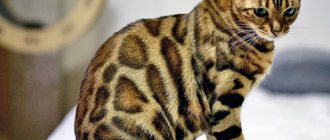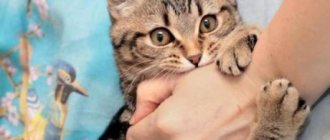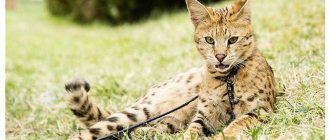The cat family includes 37 species, including cheetahs, pumas, jaguars, leopards, lions, lynxes, tigers and domestic cats. Wild cats live in all regions except Australia and Antarctica. Predators live in different places, but most often in forests.
The fur is decorated with spots or stripes, only the puma, jaguarundi and lion are of a uniform color. Black or almost black fur is found in individuals of several species. The lynx has a short tail, but most cats have a long tail, about a third of their body length. The only cat with a mane is a male African lion. Cats have sharp claws that retract, with the exception of the cheetah. In most cats, the male is larger than the female.
Clouded leopard
It has short legs, a long head, and large upper canines that are proportionally longer than those of any other cat.
Leopard
The solitary animal lives among bushes and forests. Mainly nocturnal, sometimes basking in the sun.
African lion
A muscular cat with a long body, large head and short legs. Size and appearance differ between the sexes.
Ussuri (Amur) tiger
Well adapted to harsh, snowy winters and many different biotopes. Male territories extend up to 1,000 km2.
South China tiger
The stripes of this subspecies are especially wide and spaced further apart than those of other tigers. This gives the fur a bright, impressive appearance.
Bengal tiger
This is a mammal with thick paws, strong fangs and jaws, and fur with a characteristic pattern and color. Males are larger than females.
White Tiger
A striking feature is the fur, the color due to the lack of the pigment pheomelanin, which Bengal tigers possess.
Black Panther
Incredibly smart and dexterous animals that people rarely notice in nature, since they are usually very secretive and cautious.
Jaguar
A lone predator hunts from ambushes. The name comes from an Indian word meaning "one who kills with one leap."
Snow Leopard
The coat consists of a dense undercoat and a thick outer coat that is pale grayish in color with dark spots and a stripe down the spine.
Cheetah
Active during the day, hunting early in the morning and late in the evening. It consumes prey quickly so as not to be captured by lions, leopards, jackals and hyenas.
Caracal
A short-haired cat with reddish-brown smooth fur and long tufts of black fur at the tips of its pointed ears.
African golden cat
Rodents tend to be the most common prey species, but small mammals, birds and primates are also eaten.
Kalimantan cat
For more than a hundred years, researchers could not catch a living cat. She has bright red fur with white stripes on her face and white under her tail.
Temminck's cat
Carnivorous, feeding on small prey such as the Indochinese ground squirrel, snakes and other reptiles, muntjacs, rodents, birds and young hares.
Chinese cat
With the exception of color, the cat resembles the European wildcat. Sandy fur with dark hairs, whitish belly, paws and tail with black rings.
Black-footed cat
Native to the southwestern part of Southern Africa, it lives in extremely dry conditions. It is one of the most brutal predators - 60% of hunting success.
Forest cat
Similar to a domestic cat, but with longer legs, a larger, flatter head and a relatively short tail ending in a rounded tip.
Dune cat
The coat is light sandy to grey-brown, slightly darker on the back and paler on the belly, with sparse stripes on the paws.
jungle cat
Most common in India, Bangladesh and Pakistan, Egypt, Southwest, Southeast and Central Asia, the range is expanding to southern China.
Marbled wild cat and its relatives
A cat is truly an amazing animal. When tests were done on her DNA, it turned out that she was more closely related to large representatives of the fauna than to other cats. Perhaps the animal is exactly the link that connects large and small cats. Although the mystery of the marble cat has not yet been fully revealed.
The first mentions of the marble beauty date back to the 30s of the last century. Since then, the cat has been actively studied, putting forward various versions. According to one of them, she is credited with a close relationship with the lynx, but the version has not yet been confirmed.
The marbled wild cat is a rare animal. Now there are more than ten thousand individuals living on Earth, the hunting of which is prohibited in those countries where it is found. Malaysia, Indonesia, Thailand, Nepal, Bangladesh, China and some other countries in Southeast Asia.
What does a jaguarundi eat?
Like many small wild cats, the jaguarundi prefers small and easily accessible prey. Usually these are birds, mice, frogs, fish, reptiles and even insects. But she will not refuse larger and tastier prey: armadillo, opossum, iguana, reed hamsters, guinea pigs, prickly chinchillas and Florida rabbits. This cat especially loves the latter.
Also, these wild relatives of our domestic cats sometimes like to eat fruit. For example, in Panama, they, together with monkeys, make joint raids on fig plantations.
These cats also have competitors. What could we do without it? These include: foxes, cougars, bobcats, long-tailed cats, ocelots and coyotes. As you can see, there are quite a few competitors, and they are clearly not timid.
From the history of a cat
The first animal with a marbled skin was described in 1838. The description was made by William Charles Linnaeus, a British scientist. But the animal gained protective status only in 2008, when the species began to be threatened with complete extinction and the population decreased significantly.
However, the extermination of animals, despite the prohibitions, continues to this day. For example, animal soup is highly valued in China. Gourmets are willing to pay top dollar for a plate of delicacy, which is why poaching is rampant.
Alternative eastern medicine, which used potions made from cats, contributed to the extinction of the species.
Population protection
In 2002, the Andean cat's status was upgraded from Vulnerable to Endangered on the IUCN Red List of Threatened Species.
As the habitat spread across four countries, biologists attempted to collaborate in efforts to protect the species. One of the groups formed was the Committee for the Conservation of Andean Cats, now known as the Andean Cat Union.
The direct threat to these predators is loss of habitat, and the indirect threat is various forms of land use, including mining and water extraction, which could potentially increase as a result of climate change.
Also dangerous are inappropriate pastoral and agricultural practices, unregulated tourism, secondary mineral and water extraction, and oil and gas extraction.
A separate point in preserving the species is in resolving conflicts with small livestock farming, in the fight against insufficient knowledge of the species by members of the local community, protection from dogs, accidental exposure to traps.
Scientists paid special attention to the fight against the religious use of Andean cat skins and taxidermy, hunting animals according to traditional beliefs and superstitions.
The Andean cat's habitat spans four different countries in South America. Each has enacted individual laws to protect this endangered animal.
Each country also has its own protected areas where hunting any animals is completely prohibited.
Naturalist Jim Sanderson is still concerned about the fate of the Andean cat.
Through his efforts, together with Constanza Napolitano, Lilian Villalba, Eliseo Delgado and other researchers, a conservation agreement was concluded between the Andean Cat Union and the non-profit organization Fundación Biodiversitas and the government agency CONAF, responsible for the management of national parks and industrial forests.
Villalba of the Andean Cat Union conducted a major research program, including radio telemetry studies, in the Jastor region of southern Bolivia between 2001 and 2006.
Wild marbled cat: description
Representatives of the species weigh from 4 to 8 kg. Their body length reaches 53 centimeters, and the length of their thick tail reaches up to 55 centimeters. But the legs are quite short. When moving through trees, the tail plays a huge role, thanks to which the cat easily balances on the branches.
See also: Korat cat – a mysterious Thai guest
The animal's head is wide, round in shape, the ears are set wide apart, the upper teeth are small, and the premolar is often absent.
The description of the animal’s skin deserves special attention. Black spots are scattered throughout the yellow, soft, thick fur. And if it were not for the cat’s small stature, then from a distance it could be mistaken for a leopard.
The belly is paler than the back, and the upper lip and chin are white, the ears are black, and each has a white spot “painted” on it. The iris of the eyes is brown. The voice of a cat is practically no different from the voice of its domestic relatives.
Habits and character
The marbled cat is not aggressive and leads a very secretive lifestyle. The animals are solitary animals, and therefore each individual has its own area of five to six square kilometers.
The animal mainly stays in trees, descending from them only as a last resort. The animal has one feature that distinguishes it from other cats. Animals like squirrels are able to climb tree trunks upside down.
Cats hunt primarily at night, although daytime activity is sometimes observed. They usually hide in tree branches and attack from ambush. The animals quietly creep up to their prey and make a lightning-fast jump, overtaking it.
How to eat
Cats' diet includes small rodents and predators. These are lizards, bats, toads, birds and insects. Sometimes she attacks small monkeys. Since the marbled cat mainly lives in trees, it has practically no competitors among other cats.
To kill prey, a cat bites the neck or back of the head. After the hunt is over, they take the prey to a safe place where it can be safely eaten.
How does it reproduce
Marbled cats are ready to reproduce when they are 21-22 months old. At this time, the males meow loudly and enter the territory of the females, where they mate with them. After this, all “relationships” end.
If a cat becomes pregnant, she will have to bear kittens for quite a long time, 80-85 days. After this, she gives birth to up to four babies. The offspring is born in a hollow or cave completely helpless: deaf and blind. The weight of one kitten is only 70-90 g.
See also: Javan cat or Javanese
After two weeks, the babies begin to see clearly, and after a month they begin to leave the hollow or cave. After another month they switch to meat food. Kittens remain with their mother for up to six months, and sometimes until puberty - two years. Then they begin to search for their territory and live independently.
How long does he live?
The average life expectancy of a marbled cat is 12 years. But if they live in a zoo and are cared for, the animals can live longer.
Communication and perception
Animals primarily rely on their vision, which makes it possible to see well even in complete darkness. Since marbled beauties have a rounded skull and rather flat nasal bones, their visibility is much greater than that of domestic ones.
Large eyes and vertical ellipse-shaped pupils provide maximum vision, even late at night.
Diet
Mountain Andean cats are secretive and cautious hunters; there is only speculative information about their diet. Most likely, this is an extremely poor choice due to the small amount of potential prey in the animal’s natural habitats:
- The mountain spotted viscacha is a large rodent, weighing up to three kilograms, resembling a rabbit in appearance.
- The chinchilla is a crepuscular rodent that lives in colonies.
The Andes Mountains are home to six different species of predators, three of them being cats, the Andean cat, the Pampas cat and the puma.
Of these, the puma is a large predator, and the Andean cat and the Pampas cat are medium-sized predators and are very similar. They both hunt in the same territory and the same prey due to the low genetic diversity of the area.
Vizcacha accounts for 93.9% of the biomass consumed in the Andean cat's diet. This is due to the fact that there are significantly fewer other prey objects, in addition, these rodents also lead a crepuscular lifestyle. And the Pampas cat depends on Vizcacha by 74.8%.
In some areas, the mountainous Vizcach will account for 53% of the Andean cat's production.
By the way, researchers believe that in those areas where there are few colonies of viscachas and chinchillas, Andean cats can hunt during daylight hours.
Marbled cat and its natural enemies
Its “distant relatives” from the cat family can pose a threat to animals, so the cat is very careful.
It has practically no competitors in hunting rodents. The wild Bengal cat living next door hunts mainly on the ground. So for a marbled cat that strikes game from above, it is not scary if even its relatives begin to get food for themselves nearby.
A great threat is posed by people who violate natural habitats by cutting down forests. He also continues to hunt the strange animal.
Ocelots as pets
Wild cats are often kept by people as pets. This also applies to the ocelot. Salvador Dali himself often traveled with his ocelot named Babu, even when traveling abroad.
Photo: The Great Cat
“Domestic Ocelots” is the name given to the Ocicat cat breed, which is a cross between the Abyssinian cat, the Siamese cat and the American Shorthair cat. Their originally colored fur resembles the fur of a wild ocelot, and the behavior of the animal gives the impression that this is a real South American wild cat.
Range, habitat and role in the ecosystem
The unusually beautiful skin of a wild marbled cat made it a subject of hunting. But the incredulous beauty was able to survive and moved further and further from the person. Now it can only be found in impenetrable tropical forests. She lives in 11 countries in Southeast Asia. Including Malaysia, Indonesia, Thailand, Nepal, Bangladesh, China.
Cats live in impenetrable forests, far from human habitation. Sometimes they settle in rocky areas where there are not even trees. To survive, a cat needs a territory of at least five square kilometers, of which he is the owner. Here he hunts and hides from enemies.
The main role in the ecological system is to control populations of small rodents.
What subspecies of jaguarundi are there and where do they live?
These cats live in Central and South America, from the coast of Mexico to the north-west of Argentina. I sometimes see them in Arizona and Texas.
To date, 8 subspecies of jaguarundi are known:
- Puma yagouaroundi ameghini - lives mainly in Argentina;
- Puma yagouaroundi cacomitli - prefers southern Texas and Mexico;
- Puma yagouaroundi eyra (bright red) - lives in Brazil, Paraguay and Argentina;
- Puma yagouaroundi fossata - mainly in Mexico and Honduras;
- Puma yagouaroundi melantho - prefers Peru and Brazil;
- Puma yagouaroundi panamensis - prefers places from Nicaragua to Ecuador;
- Puma yagouaroundi tolteca – seen in Arizona and Mexico;
- Puma yagouaroundi yagouaroundi - common in the rainforests of Guyana and the forests of the Amazon.
Like all cats, they mark their territory by urinating and feces, and also by rubbing their cheeks against trees, leaving their scent.
Conservation status of the wild marbled cat
Since the marbled cat is a rare species, the population is listed in the Convention on International Trade (CITES (Appendix 1). That is, international trade in this species is prohibited. Cats reproduce better and maintain the population in their natural habitat. They are also listed in the International Red Book and books those countries in whose territory their habitats are located
See also: Evil cat: which cat has the worst character
There are now two known species of animals:
- Pardofelis marmorata marmorata lives in southeast tropical Asia.
- Pardofelis marmorata charltoni - lives in Nepal.
Purchasing a kitten
It's not so easy to buy a kitten. Or rather, it is unlikely that it will be possible to do this legally, unless you enter into an agreement for an unborn baby from the zoo. Organizations are prohibited from selling animals into private hands almost everywhere.
Margay kittens are purchased illegally through resellers of smuggled goods. Poachers catch kittens in their native habitat and transport them through well-established distribution channels to large developed countries.
The exotic goods business, unfortunately, is still considered profitable and thriving. Therefore, the cost of a poacher’s kitten is high - about 30 thousand dollars.
These rare cats are on the verge of extinction; only a miracle and man himself can save them and preserve the pearl of the planet if they stop shooting and poaching Margays. Therefore, you should not support the business of poachers and smugglers and illegally purchase this exotic miracle.
Can cats live in captivity?
The marbled cat kitten is quite easy to tame. Although it is difficult to catch a wild cat, residents of the countries where the animals live sometimes bring them from the forest. There are cases when kittens even appeared from marbled and domestic cats. The animals were quite viable, but they had no offspring.
Due to the low population size, marbled cats are not allowed to be removed from their habitats. But poaching is rampant because cats are very expensive. Sometimes some specimens are even smuggled to Europe. It is possible that they are in private menageries in our country. But since the export of animals is prohibited, their presence in zoos is a secret.
Now officially marbled beauties live in ten zoos around the world, where all conditions have been created for them: spacious enclosures with a complex landscape, shelters where cats hide during the day. Therefore, it is difficult to see a cat in a zoo. However, some visitors manage to take photographs of this amazing and rare creature.
One Russian woman, who really wanted to capture a marble cat, “hunted” for it for two days. On the first day, the capricious animal did not appear. And on the second day, the woman came to the zoo closer to closing, and at dusk she managed to see and photograph the animal.
They are already thinking about getting serious about breeding marbled cats in captivity. Although representatives of the breed sometimes produce kittens, there is no serious breeding program for cats in zoos yet.
Geographical distribution
Photo: DEV Community
The ocelot can now be found in South and Central America, as well as along both coasts of Mexico, in the southern parts of the United States and on islands such as Trinidad or Margarita. The largest populations are found in Central America.
- Biogeographic regions: neotropical (native)










